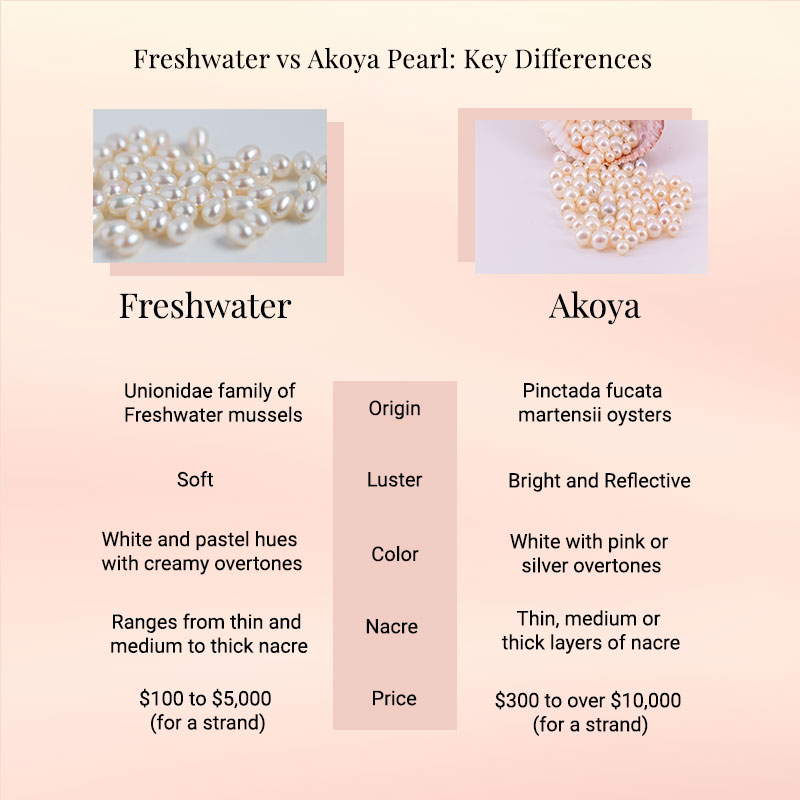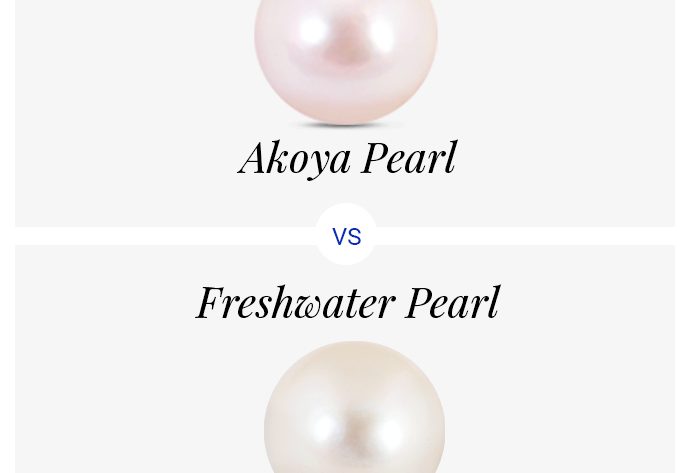All pearls may look similar to the naked eye but in reality, that is never the case. If you plan to buy jewellery featuring this gem, then don’t miss our comparative analysis between Akoya and Freshwater pearls, two of the most popular cultured pearl varieties. This will definitely help you make the right choice.
What Are the Main Differences Between Akoya and Freshwater Pearls?

1. Rarity:
Akoya pearls are rarer than Freshwater pearls. A single Akoya pearl takes 18 to 24 months to form. On the other hand, Freshwater pearls are more easily available as Freshwater mussels can produce up to 25 pearls in one go.
2. Colour:
Akoya pearls usually come in neutral hues. They have a sought-after white colour with silver or pink overtones, whereas Freshwater pearls have delightful white and natural pastel hues with creamy overtones.
Angara says: If you adore pearls for their classic white hue, Akoya pearls are just what you need.
3. Origin & Formation:
Akoya pearls are formed within the Pinctada fucata martensii saltwater oysters and are mainly produced in Japan. They are also sourced from China, South Korea, Vietnam and Australia. Freshwater pearls come from the Unionidae family of Freshwater mussels. These pearls are produced in pearl farms in China, Japan and the US.
Did you know: Akoya pearls come from the world’s smallest pearl oyster. Fascinating, isn’t it?
4. History & Symbolism:
The ancient Japanese believed that pearls were formed from the tears of mermaids and angels. In China, it was believed that pearls kept one safe from fire and dragons. What’s more, in many cultures, pearls were said to represent the moon.
Even today, all pearl types are said to symbolize purity, faith, transformation, wisdom and wealth. White pearls like the Japanese Akoya are associated with new beginnings, innocence and beauty, thanks to their pristine hue.
Angara says: The stone for the 3rd, 30th, 46th, 50th and 52nd wedding anniversaries is none other than the pearl that stands for purity, prosperity and everlasting love. So, how about treating your partner with this underwater treasure to celebrate your love milestone?
5. Shape:
Akoya pearls are known for their perfect round shape while Freshwater pearls usually have an off-round shape.
6. Size:
Freshwater pearl sizes range from 4mm to 11mm and above. Akoya pearls are available in sizes between 4mm and 9.5mm. However, extremely rare Akoya pearls measure 9.5mm to 10mm in size.
7. Nacre Thickness:
Nacre or calcium carbonate is secreted by the oyster or mussel while a pearl is being formed. This nacre determines the quality and lustre of the pearl. While pearl nacre can range from thin and medium to thick, top-quality Akoya and Freshwater pearls have thicker layers of nacre.
8. Lustre:
Pearl lustre can vary depending on the quality of the pearl. The best quality Akoya pearls exude a strong, reflective lustre while good quality Freshwater pearls have a soft, bright lustre.
9. Natural Flaws (Blemishes):
The best quality Freshwater pearls tend to have smooth, clean, mirror-like surfaces, whereas Akoya pearls may have minor blemishes on their surface.
10. Birthstone & Zodiac Sign:
Pearl is the official birthstone for June. All pearl types including Freshwater and Akoya pearls are considered June birthstones. They are also the official birthstone for the Gemini zodiac.
11. Grading:
Pearl grades range from A to AAAA or good to heirloom quality. Both Akoya and Freshwater pearls are graded based on their lustre, colour, surface, shape, size and nacre.
12. Pricing:
Freshwater pearls are more affordable compared to Akoya pearls. Freshwater pearl prices range from $100 to above $5,000. Akoya pearl prices start at $300 on average and can go well above $10,000. The prices also vary depending on the pearl quality grade.
Good to Know:
Pearls, unlike other gemstones, are not found underground. Instead, they are formed in living organisms like oysters and mussels. Since naturally produced pearls are almost extinct, the demand for cultured pearls produced in pearl farms has increased exponentially in the last century.
Why Should You Buy Akoya Pearls?
Akoya pearls are loved for their charming white hue and perfectly round shape. The best quality Akoya pearls are also known for their reflective lustre and a metallic sheen. That’s not all, this rare pearl is also considered a symbol of new beginnings, due to its classic white colour.
Wish to add some classics to your jewellery box?
Why Should You Buy Freshwater Pearls?
Popular, affordable yet no less alluring – what more reason could you need to buy Freshwater pearls?
Freshwater pearls are available in white and pastel hues. They also have beautiful creamy overtones. What’s more, they have an off-round shape and exude a soft, subtle glow.
Can’t wait to get your hands on some delightful sea treasures?
Verdict:
Akoya pearls have a perfectly round shape with almost negligible variation, which makes them a great choice for jewellery. Bright lustre and neutral colours also add to their popularity. When compared to other varieties, such as Tahitian and South Sea, Akoya pearls definitely offer good value for money without compromising on beauty.
Freshwater pearls lack the deep, beautiful gleam of an Akoya. However, the palette of colours and attractive pricing makes them a great option for many people.
For more in-depth information on gemstones, please refer to our handy jewellery guides.
Angara’s Collection of Akoya and Freshwater Pearl Jewellery
Angara brings to you a wide range of charming and elegant pearl jewellery. You can take your pick from rings, earrings, pendants and bracelets adorned with Akoya and Freshwater pearls. What’s more, you can choose from Akoya and Freshwater pearl strands that will instantly give your ensemble a sophisticated touch.
Need another reason to buy Freshwater and Akoya pearl jewellery at Angara store? Well, you get to customise your favourite pieces just the way you like. You can choose the pearl quality grade, pearl size and metal you prefer, to create a unique piece for your collection according to your budget.
All our pieces come with a Certificate of Authenticity that tells you everything you need to know about the pearls in your jewellery piece.
Akoya Vs Freshwater Pearl FAQs
- Why are Akoya pearls costlier than Freshwater pearls?Yes, Akoya pearls are more expensive than Freshwater pearls due to their rarity and longer production cycle.
- Do pearls turn yellow with age?Yes, white pearls slowly turn yellow with age. However, you can clean them gently and restore their color and luster with some water and a soft cloth.
- What kind of sea pearl is the most expensive one?Cultured South Sea pearls are considered the most expensive and luxurious type of pearls.




























